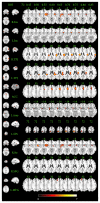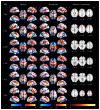Long-term effects of musical training and functional plasticity in salience system
- PMID: 25478236
- PMCID: PMC4247966
- DOI: 10.1155/2014/180138
Long-term effects of musical training and functional plasticity in salience system
Abstract
Musicians undergoing long-term musical training show improved emotional and cognitive function, which suggests the presence of neuroplasticity. The structural and functional impacts of the human brain have been observed in musicians. In this study, we used data-driven functional connectivity analysis to map local and distant functional connectivity in resting-state functional magnetic resonance imaging data from 28 professional musicians and 28 nonmusicians. Compared with nonmusicians, musicians exhibited significantly greater local functional connectivity density in 10 regions, including the bilateral dorsal anterior cingulate cortex, anterior insula, and anterior temporoparietal junction. A distant functional connectivity analysis demonstrated that most of these regions were included in salience system, which is associated with high-level cognitive control and fundamental attentional process. Additionally, musicians had significantly greater functional integration in this system, especially for connections to the left insula. Increased functional connectivity between the left insula and right temporoparietal junction may be a response to long-term musical training. Our findings indicate that the improvement of salience network is involved in musical training. The salience system may represent a new avenue for exploration regarding the underlying foundations of enhanced higher-level cognitive processes in musicians.
Figures






References
Publication types
MeSH terms
LinkOut - more resources
Full Text Sources
Other Literature Sources

